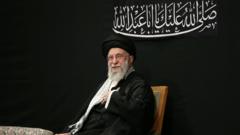As Prime Minister Benjamin Netanyahu heads to Washington for a meeting with President Trump, the agenda appears two-fold: advancing the ceasefire negotiations in Gaza while navigating the complex aftermath of a recent conflict with Iran.
Netanyahu's U.S. Visit: A Dual Focus on Gaza Ceasefire and Nuclear Tensions

Netanyahu's U.S. Visit: A Dual Focus on Gaza Ceasefire and Nuclear Tensions
Israeli Prime Minister Benjamin Netanyahu gears up for a crucial meeting with President Trump amid ongoing ceasefire efforts in Gaza and lingering tensions with Iran.
Last month, Netanyahu had to deal with an intense 12-day conflict triggered by Hamas’ surprise attack on Israel on October 7. In the wake of this chaos, the prime minister's trip to the White House, set for Monday, is seen as both a political milestone and a strategy to gather support ahead of an upcoming election year in Israel. His victory lap follows a collaborative Israeli-U.S. operation targeting Iranian nuclear sites, a significant move that has fortified Netanyahu's standing at home.
However, past visits to the Oval Office have occasionally taken unexpected turns. During his last meeting with Trump in April, Netanyahu found himself awkwardly sidelined as Trump announced plans for direct talks with Iran regarding its nuclear ambitions. In stark contrast, this time, Trump appears keen to establish a ceasefire agreement that would facilitate Hamas releasing hostages and help bring to an end the prolonged strife gripping Gaza.
Compounding the situation, Israel has also dispatched negotiators to Qatar, seeking to reconcile differences with Hamas through mediation. Meanwhile, the U.S. has taken an active role in mediating discussions between Israel and Syria, aiming to restore stability along their shared borders. As the geopolitical landscape remains fluid, both leaders are likely aware that the outcomes of these discussions will have lasting implications for the region’s peace and security.
However, past visits to the Oval Office have occasionally taken unexpected turns. During his last meeting with Trump in April, Netanyahu found himself awkwardly sidelined as Trump announced plans for direct talks with Iran regarding its nuclear ambitions. In stark contrast, this time, Trump appears keen to establish a ceasefire agreement that would facilitate Hamas releasing hostages and help bring to an end the prolonged strife gripping Gaza.
Compounding the situation, Israel has also dispatched negotiators to Qatar, seeking to reconcile differences with Hamas through mediation. Meanwhile, the U.S. has taken an active role in mediating discussions between Israel and Syria, aiming to restore stability along their shared borders. As the geopolitical landscape remains fluid, both leaders are likely aware that the outcomes of these discussions will have lasting implications for the region’s peace and security.



















